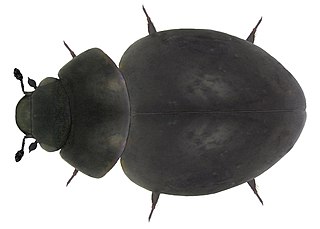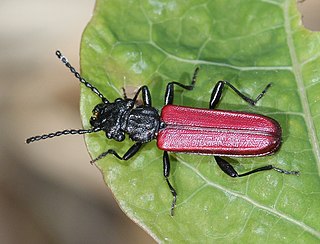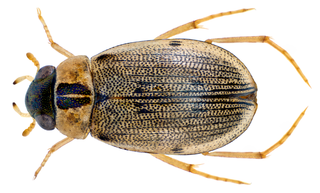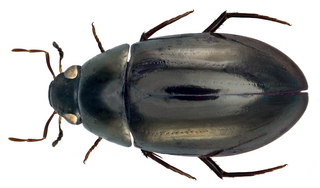
A water beetle is a generalized name for any beetle that is adapted to living in water at any point in its life cycle. Most water beetles can only live in fresh water, with a few marine species that live in the intertidal zone or littoral zone. There are approximately 2000 species of true water beetles native to lands throughout the world.

Sphaerius is a genus of beetles in the family Sphaeriusidae, comprising 18 species. It is one of the two extant genera in the family, the other being Bezesporum. They are typically found along the edges of streams and rivers, where they feed on algae; they occur on all continents except Antarctica. Three species occur in the United States.

Amphizoa is a genus of aquatic beetles in the suborder Adephaga, placed in its own monogeneric family, Amphizoidae. There are five known species of Amphizoa, three in western North America and two in the eastern Palearctic. They are sometimes referred to by the common name troutstream beetles.

Hydrophilidae, also known colloquially as water scavenger beetles, is a family of beetles. Aquatic hydrophilids are notable for their long maxillary palps, which are longer than their antennae. Several of the former subfamilies of Hydrophilidae have recently been removed and elevated to family rank; Epimetopidae, Georissidae, Helophoridae, Hydrochidae, and Spercheidae. While the majority of hydrophilids are aquatic, around a third of described species are terrestrial, mostly belonging to the subfamily Sphaeridiinae.

The Cucujidae, "flat bark beetles," are a family of distinctively flat beetles found worldwide under the bark of dead trees. The family has received considerable taxonomic attention in recent years and now consists of 70 species distributed in five genera. It was indicated Cucujus species are scavengers, only feeding on pupae and larvae of other insects and on other subcortical beetles such as their own. Since the Cucujidae prey on larvae of potentially tree damaging beetles that spread fungal diseases, they are considered to be beneficial to the health of living trees.

Myxophaga is the second-smallest suborder of the Coleoptera after Archostemata, consisting of roughly 65 species of small to minute beetles in four families. The members of this suborder are aquatic and semiaquatic, and feed on algae.

Hydraenidae is a family of very small aquatic beetles, sometimes called "Minute moss beetles", with a worldwide distribution. They are around 0.8 to 3.3 mm in length. The adults store air on the underside of the body as well as beneath the elytra which allows them to crawl underwater, often on the underside of the water surface tension, though they cannot swim. Some species have gills that effectively allow them to stay underwater indefinitely. Larvae vary from being fully terrestrial, to being aquatic at least in their earliest instars. The diet of hydraenid larvae and adults is thought to consist of algae, spores and other plant matter. At least some hydraenid adults use stridulation to communicate. There are around 1,300 species in 42 genera.

The Donaciinae are a subfamily of the leaf beetles, or Chrysomelidae, characterised by distinctly long antennae. They are found in mainly the Northern Hemisphere, with some species found in the Southern Hemisphere.

Hygrobia is a genus of aquatic beetles native to Europe, North Africa, China and Australia. It is the only genus in the family Hygrobiidae, also known as the Paelobiidae. These are known commonly as squeak beetles or screech-beetles.

Ancyronyx, commonly known as spider water beetles or spider riffle beetles, is a genus of aquatic riffle beetles from North America, South Asia, China, and Southeast Asia. They are small beetles with extremely long legs ending in strong claws. Both the adults and the larvae are found underwater in the shallow riffles of streams and rivers, clinging to rocks or submerged wood. They feed on algae and decaying wood tissue. The genus contains twenty-one species, eleven of which are endemic to the Philippines.
Harley Procter Brown Jr. was an American biologist and an expert in certain types of aquatic beetles. He described over forty new species in his career.
Hydraena angulicollis is a species of minute moss beetle in the family Hydraenidae. It is found in North America.

Hydraena is a genus of minute moss beetles in the family Hydraenidae. There are more than 990 described species in Hydraena.
Hydraena circulata is a species of minute moss beetle in the family Hydraenidae. It is found in Central America and North America.

Aspidytidae is a family of aquatic beetles of the suborder Adephaga, described in 2002 from specimens in South Africa and China. There are only two known species in the family and these were originally described in the genus Aspidytes, but later the new genus Sinaspidytes was erected for the species found in China. The family can also be referred to by its trivial name cliff water beetles.

Berosus pulchellus, is a species of water scavenger beetle found in Oriental, Australasian, Afrotropical and Palaearctic regional countries such as India, Sri Lanka, Hong Kong, Japan, Iran, Cambodia and Australia.

Enochrus (Methydrus) esuriens, is a species of water scavenger beetle found in Indochina, Korea, China, Japan, Bhutan, Iran, Iraq, Nepal, India, Pakistan, Philippines, Sri Lanka, Vietnam, Sunda Island, Saudi Arabia and Australia.

Sternolophus inconspicuus, is a species of water scavenger beetle found in India, Sri Lanka, Tibet, Hong Kong, Vietnam and the Philippines.
Melanotus punctosus, is a species of click beetle found in India, Sri Lanka, Pakistan, and Hawaii.

Angat Buhay Foundation, incorporated as Angat Pinas, Inc., is a non-profit, non-governmental organization based in the Philippines. It was founded and officially launched on July 1, 2022, a day after its founder Leni Robredo's term as Vice President of the Philippines expired.
















